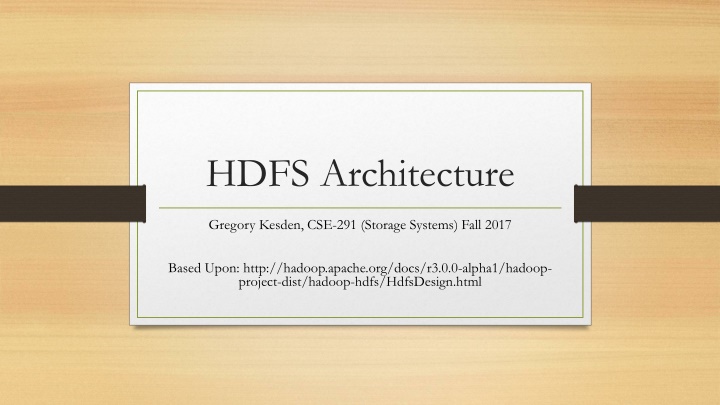Overview of HDFS Architecture
HDFS (Hadoop Distributed File System) is designed for handling large data sets across commodity hardware. It emphasizes throughput over latency and is well-suited for batch processing applications. The architecture includes components like NameNode (master) and DataNode (participants), focusing on scalability and fault tolerance. Simple coherency models and hierarchical namespace management provide efficient data storage and retrieval. The system is optimized for managing massive amounts of data with continued availability and automatic recovery mechanisms.
Download Presentation

Please find below an Image/Link to download the presentation.
The content on the website is provided AS IS for your information and personal use only. It may not be sold, licensed, or shared on other websites without obtaining consent from the author.If you encounter any issues during the download, it is possible that the publisher has removed the file from their server.
You are allowed to download the files provided on this website for personal or commercial use, subject to the condition that they are used lawfully. All files are the property of their respective owners.
The content on the website is provided AS IS for your information and personal use only. It may not be sold, licensed, or shared on other websites without obtaining consent from the author.
E N D
Presentation Transcript
HDFS Architecture Gregory Kesden, CSE-291 (Storage Systems) Fall 2017 Based Upon: http://hadoop.apache.org/docs/r3.0.0-alpha1/hadoop- project-dist/hadoop-hdfs/HdfsDesign.html
Assumptions At scale, hardware failure is the norm, not the exception Continued availability via quick detection and work-around, and eventual automatic rull recovery is key Applications stream data for batch processing Not designed for random access, editing, interactive use, etc Emphasis is on throughput, not latency Large data sets Tens of millions of files many terabytes per instance
Assumptions, continued Simple Coherency Model = Lower overhead, higher throughput Write Once, Read Many (WORM) Gets rid of most concurrency control and resulting need for slow, blocking coordination Moving computation is cheaper than moving data The data is huge, the network is relatively slow, and the computation per unit of data is small. Moving (Migration) may not be necessary mostly just placement of computation Portability, even across heterogeneous infrastructure At scale, things can be different, fundamentally, or as updates roll-out
NameNode Master-slave architecture 1x NameNode (coordinator) Manages name space, coordinates for clients Directory lookups and changes Block to DataNode mappings Files are composed of blocks Blocks are stored by DataNodes Note: User data never comes to or from a NameNode. The NameNode just coordinates
DataNode Many DataNodes (participants) One per node in the cluster. Represent the node to the NameNode Manage storage attached to node Handles read(), write() requests, etc for clients Store blocks as per NameNode Create and Delete blocks, Replicate Blocks
Namespace Hierarchical name space Directories, subdirectories, and files Managed by NameNode Maybe not needed, but low overhead Files are huge and processed in entirety Name to block lookups are rare Remember, model is streaming of large files for processing Throughput, not latency, is optimized
Access Model (Just to be really clear) Read anywhere Streaming is in parallel across blocks across DataNodes Write only at end (append) Delete whole file (rare) No edit/random write, etc
Replication Blocks are replicated by default Blocks are all same size (except tail) Fault tolerance Opportunities for parallelism NameNode managed replication Based upon heartbeats, block reports (per dataNode report of available blocks), and replication factor for file (per file metadata)
Location Awareness Site + 3-Tier Model is default
Replica Placement and Selection Assume bandwidth within rack greater than outside of rack Default placement 2 nodes on same rack, one different rack (Beyond 3? Random, below replicas/rack limit) Fault tolerance, parallelism, lower network overhead than spreading farther Read from closest replica (rack, site, global)
Filesystem Metadata Persistence EditLog keeps all metadata changes. Stored in local host FS FSImage keeps all FS metadata Also stored in local host FS FSImage kept in memory for use Periodically (time interval, operation count), merges in changes and checkpoints Can truncate EditLog via checkpoint Multiple copies of files can be kept for robustness Kept in sync Slows down, but okay given infrequency of metadata changes.
Failure of DataNodes Disk Failure, Node Failure, Partitioning Detect via heartbeats (long delay, by default), blockmaps, etc Re-Replicate Corruption Detectable by client via checksums Client can determine what to do (nothing is an option) Metadata
Datablocks, Staging Data blocks are large to minimize overhead for large files Staging Initial creation and writes are cached locally and delayed, request goes to NameNode when 1stchunk is full. Local caching is intended to support use of memory hierarchy and throughput needed for streaming. Don t want to block for remote end. Replication is from replica to replica, Replication pipeline Maximizes client s ability to stream























